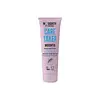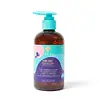What's inside
What's inside
 Benefits
Benefits

 Concerns
Concerns

 Ingredients Side-by-side
Ingredients Side-by-side

Water
Skin ConditioningCocamidopropyl Betaine
CleansingSodium Cocoyl Methyl Isethionate
Glycerin
HumectantPhenoxyethanol
PreservativeSodium Lauroyl Sarcosinate
CleansingSodium Methyl Isethionate
EmulsifyingSodium Cocoate
CleansingCoco-Glucoside
CleansingCoconut Acid
CleansingWheat Amino Acids
Skin ConditioningAvena Sativa Meal Extract
SoothingBisabolol
MaskingPolyquaternium-6
Glycol Distearate
EmollientTrisodium Ethylenediamine Disuccinate
Disodium EDTA
Potassium Sorbate
PreservativeSodium Benzoate
MaskingCitric Acid
BufferingSodium Chloride
MaskingWater, Cocamidopropyl Betaine, Sodium Cocoyl Methyl Isethionate, Glycerin, Phenoxyethanol, Sodium Lauroyl Sarcosinate, Sodium Methyl Isethionate, Sodium Cocoate, Coco-Glucoside, Coconut Acid, Wheat Amino Acids, Avena Sativa Meal Extract, Bisabolol, Polyquaternium-6, Glycol Distearate, Trisodium Ethylenediamine Disuccinate, Disodium EDTA, Potassium Sorbate, Sodium Benzoate, Citric Acid, Sodium Chloride
Ingredients Explained
These ingredients are found in both products.
Ingredients higher up in an ingredient list are typically present in a larger amount.
Citric Acid is an alpha hydroxy acid (AHA) naturally found in citrus fruits like oranges, lemons, and limes.
Like other AHAs, citric acid can exfoliate skin by breaking down the bonds that hold dead skin cells together. This helps reveal smoother and brighter skin underneath.
However, this exfoliating effect only happens at high concentrations (20%) which can be hard to find in cosmetic products.
Due to this, citric acid is usually included in small amounts as a pH adjuster. This helps keep products slightly more acidic and compatible with skin's natural pH.
In skincare formulas, citric acid can:
While it can provide some skin benefits, research shows lactic acid and glycolic acid are generally more effective and less irritating exfoliants.
Most citric acid used in skincare today is made by fermenting sugars (usually from molasses). This synthetic version is identical to the natural citrus form but easier to stabilize and use in formulations.
Read more about some other popular AHA's here:
Learn more about Citric AcidPhenoxyethanol is a preservative that has germicide, antimicrobial, and aromatic properties. Studies show that phenoxyethanol can prevent microbial growth. By itself, it has a scent that is similar to that of a rose.
It's often used in formulations along with Caprylyl Glycol to preserve the shelf life of products.
Sodium Benzoate is a preservative. It's used in both cosmetic and food products to inhibit the growth of mold and bacteria. It is typically produced synthetically.
Both the US FDA and EU Health Committee have approved the use of sodium benzoate. In the US, levels of 0.1% (of the total product) are allowed.
Sodium benzoate works as a preservative by inhibiting the growth of bacteria inside of cells. It prevents the cell from fermenting a type of sugar using an enzyme called phosphofructokinase.
It is the salt of benzoic acid. Foods containing sodium benzoate include soda, salad dressings, condiments, fruit juices, wines, and snack foods.
Studies for using ascorbic acid and sodium benzoate in cosmetics are lacking, especially in skincare routines with multiple steps.
We always recommend speaking with a professional, such as a dermatologist, if you have any concerns.
Learn more about Sodium BenzoateWater. It's the most common cosmetic ingredient of all. You'll usually see it at the top of ingredient lists, meaning that it makes up the largest part of the product.
So why is it so popular? Water most often acts as a solvent - this means that it helps dissolve other ingredients into the formulation.
You'll also recognize water as that liquid we all need to stay alive. If you see this, drink a glass of water. Stay hydrated!
Learn more about Water